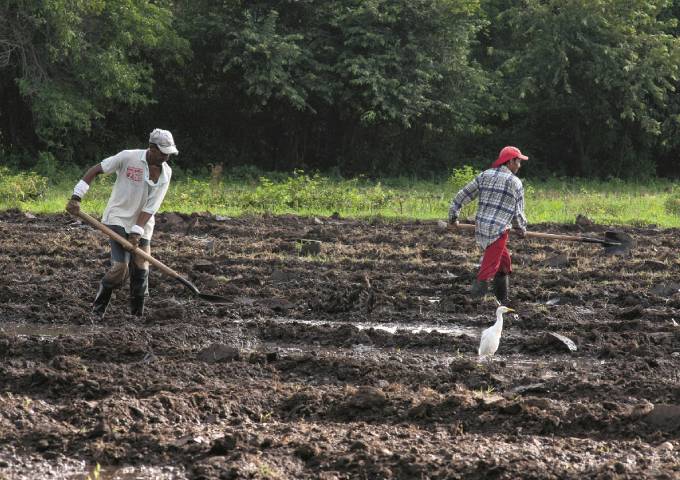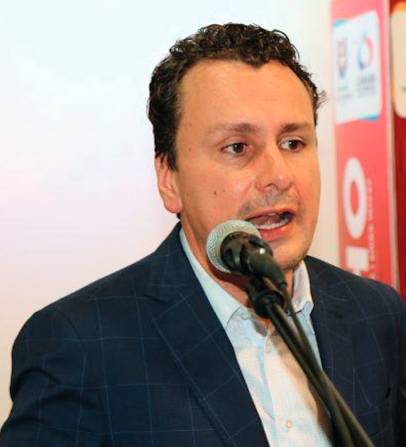Mechanism proposal to reactivate the agro-industry and dignify farmers
By: Alejandro Ramírez Peña
Photos:
Economics and Politics

By: Alejandro Ramírez Peña
Photos:
When the peace process negotiations began, one of the high points in the discussions was rural reform. It was agreed that this would be comprehensive, but it is still unclear how this should be achieved. Researchers Tatiana Oñate Acosta, Luisa Fernanda García, and Francisco Ternera, professors at the Faculty of Law of the Universidad del Rosario, have some ideas to achieve this.
After analyzing the different edges in the Private Law Research Group of the Faculty of Law and having spent several years studying the issues linked to property, particularly, state property, they consider that the answer lies in the figure of law called emphyteusis, a real right that consists in giving the property of land to a person and the possibility of taking economic advantage of this to a third party, with the obligation to pay an annual rent.
“Through the right of emphyteusis, third parties (the leaseholder) could enter, who would make the different long-term investments, without the farmers ceasing to be the owners of the land. Of course, third parties would obtain benefits for the resources provided. Another very important peculiarity is that this right is transferred due to death, that is, if the farmer dies during the period in which the project is being carried out, the property will pass into the hands of his heirs, which today with the usufruct model would be impossible,” Oñate emphasizes.
The professors reached this conclusion after reviewing why despite the fact that in the country, there have been several legal figures to guarantee farmers access to land, they always end up in the same situation that they classify as a “vicious circle.” This is that the land is given to the farmer, but he or she does not have the resources to exploit it, and those who do, the large companies, cannot receive it because in Colombian legislation, it is forbidden that the land that belongs to the State can pass, as a rule, into private hands.
However, they are the ones who have the muscle to make the investments required and generate production in the field.
Thus, according to the researchers, the great challenge surrounding comprehensive rural reform is to give the Colombian farmer access to land with a series of conditions that allow it to be productive. This is what the concept of rural development has focused on in recent decades.
From analyzing this reality, the motivation of these profesors arose to find a figure that could reconcile these two interests, as they left it reflected in the article For the right of emphyteusis: Defense of a useful dismemberment of property.
Oñate and Ternera show in their writing that the situation of the rural sector in Colombia is complex, in addition to the above, due to two factors: Availability of arable land is limited and there are commitments for protected areas and forest reserve areas where economic exploitation is not possible.
In addition, the lands that have the option of being cultivated must prioritize the rights of black communities and indigenous reservations, among others; the map of the territorial extension of Colombia to be cultivated and economically exploited is extremely small and incipient in relation to the needs to be satisfied.
For this and other reasons, the researchers do not hesitate to describe the situation of the people who work the land as painful. Moreover, the main characteristic concerning the exploitation of this resource is informality since the farmers who manage to cultivate it or have some productive activity on a specific land do not have the title or right to allow them the peace of mind of knowing that they can stay and remain in that place.
armed conflict and the limitations to establish how much territory there is, to whom it belongs, and what areas are available to formalize them, affect this problem. Similarly, the difficulty in accessing credit, entrepreneurship policies, and training, among others, are other factors.
“We do not have mechanisms that facilitate the cadastral identification of the properties, so measures have been taken to solve these problems. All are aligned with the possibility of formalizing this,” explains Oñate.
Seeking the solution
According to the analysis carried out by the researchers, the land has generallybeen exploited by people who have the status of possessors (informal exploiters) or holders (tenants of properties). However, this is not reflected in the current law known as the dismemberment of the property because only two figures are referred to when thinking about the possibility that someone may be the owner of rights to the property together with the owner (with all the powers and faculties over the property to use it, enjoy it and dispose of it), which are usufruct and use, and habitation.
“What we evaluated when we wrote the article is that those current figures of the dismemberment of the property, that is, where two holders of real rights are going to be allowed to coexist (one who is the owner and the other who acts as usufructuary), will not have the 'courage' that would be required so that in this coexistence of rights, the two parties could obtain a benefit that gives the possibility of access to land with economic conditions aimed at allowing such exploitation,” says the professor.
The professor notes that the usufruct in Colombia has served almost no function. It is practically the only dismemberment of the property and does not seem to have a clear purpose. “It has even been used in some scenarios to evade tax burdens at the family level, which is not necessarily prohibited, but in this area, it has been given an anticipatory approach to succession. The living parents become usufructuaries, and the children become bare owners in such a way that when the parents die, the bare owner becomes the owner,” explains Ternera. He adds that beyond this application at the level of family law, there is no incidence of usufruct in general.
Moreover, he and Professor Oñate indicate that the figure of emphyteusis law may have an important role in this situation, as it does in other countries, mainly in Europe—not only in the agricultural sector but also in the urban sector—because it can be a valuable and useful tool in building wealth and entrepreneurship.
In his concept, he can answer the eternal question: In whose hands should the land in Colombia be? For them, this mechanism allows the land to be in the hands of farmers, who would be the owners of the goods, and a third party who would have the necessary resources and infrastructure to be able to take advantage of it. In this way, farmers’ fear of owning because they lack the ways to make use of the land would end, and there would be an advantageous relationship for everyone, including the same land, since it will allow the best practices to be given in the different agro-industrial activities.
"We believe that this mechanism can ensure that farmers have a dignified life, dedicating themselves to licit crops, so we must create spaces to discuss it in more detail and learn about other visions that are not exclusively legal," notes the researcher. She gives one more element in favor of the figure of emphyteusis: It will make it possible to overcome the obstacle of the reduced number of hectares to exploit economically.
“So, if the figure of the emphyteusis law is adapted as it is conceived in other legal systems, and we do not try to create a mixed version of several models calling it surface law (as has been discussed at some point), it can work for Colombia,” emphasizes the researcher.

"We believe that this mechanism can ensure that farmers have a dignified life, dedicating themselves to licit crops, so it is necessary to create spaces to discuss it in more detail and learn about other visions that are not exclusively legal," notes Tatiana Oñate Acosta, researcher from the Universidad del Rosario.

Francisco Ternera, professor at the Faculty of Law, maintains that the usufruct in Colombia has served almost no function. It is practically the only dismemberment of the property and does not seem to have a clear purpose.
Multipurpose cadaster, the key element for decision-making
Professors Tatiana Margarita Oñate, Luisa Fernanda García, and Francisco Ternera are clear that the proposal of the figure of emphyteusis requires in-depth discussion about the different elements involved. While this is happening, they are asking for progress in the multipurpose cadaster and in the tasks assigned to the Agencia Nacional de Tierras (National Land Agency, ANT) and the Agencia de Desarrollo Rural, ADR (Rural Development Agency).
They explain that in the last year, Colombia received a loan to update its cadaster and thus have real information on the properties. “The country will know what the size of the land is, how many hectares are available to be exploited, what has happened to the properties, how much the owner should pay for it, and what are taxes on those lands. In other words, it will provide the data required for all topics related to the land,” explains Oñate.
As for the entities created to lead the comprehensive rural reform and thus improve the situation in the land, they maintain that both have been working hard. The ANT, in everything related to formalization through traditional mechanisms, and the ADR, in the structuring and allocation of resources for productive projects.
"As long as these institutions can count on the resources and remain within the administrative structure, progress can be made to take up the issue of the figure of emphyteusis,”state the researchers.